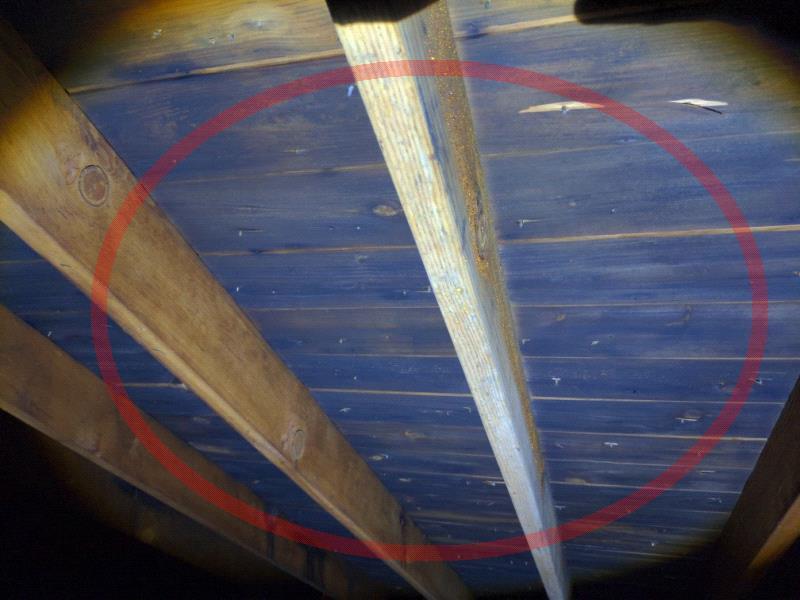NJ Home inspectors often discover mold growth in attic of the homes they are inspecting. Attics are an important portion of the home often being used for storage and sometimes having the homes mechanicals such as furnaces and water heater units. Mold in attics can be a significant health hazard for the occupants and can also cause damage to the structural roof components.
We all know that mold is a fungus that establishes itself in moist environments. Mold spores settle on surfaces and then begin to grow and expand. The role of mold in the environment is to break down organic materials, however mold in a home can break down the structural components of a wood framed home over time.
If mold requires moisture to begin its growth where does the moisture come from? Moisture comes from several sources in a home. One of the biggest culprits is improperly vented kitchens and bathrooms. Kitchens and bathrooms are the big moisture makers in homes. when people shower or bathe or cook gallons of moisture is entering into the air. As the moisture enters the rooms it wants to move in an upward direction. Because it wants to move upward the moisture often migrates into the attic space settling on the underside of the roof and the roof framing. Moisture makes its way into an attic space because it enters openings. Such openings consist of wire penetrations, the attic access hatch or scuttle, high hat light fixtures, and bath and kitchens that are discharging improperly into the attic space. All area or pathways of possible moisture entrance into an attic should be sealed.
One such major culprit is the attic pull down or the attic scuttle hatch. These openings are often not well sealed and often will have gaps creating a wide pathway for moisture to enter the attic without resistance. High hat light fixtures are another major source of moisture pathway. They are often the older style lights that are just open into the attic and are often poorly sealed.
Other issue that causes moisture to enter the attic space is poorly insulated homes. When a home is properly insulated moisture diffusion is slowed down. Insulation slows down the rate of moisture that enters the attic space. Proper insulation in the northeast part of the county is an R-38 which depending on the insulation manufacturer is between 13-15 inches of insulation. NJ home inspectors should verify that the attic is properly insulated to aid in keeping moisture at at a minimum in the attic space.
Inadequate attic ventilation will also cause high moisture conditions and allow mold to grow. Proper ventilation will help prevent moisture from being trapped in the attic space. Home inspectors in New Jersey should make sure that the attic they are inspecting is properly ventilated. Attic ventilation typically is accomplished by the installation of three types of vents. Soffit vents which are installed under the eave areas provide air intake and ridge vents which are located high in the roof ridge provide air expulsion. There are often gable vents as well that provide attic cross ventilation. A common issue that home inspectors find is the soffit vents being blocked by insulation. Soffit vents need to be open to work properly. Seeing areas of day light in these vents is actually a good and beneficial thing. Baffles which are Styrofoam channels are often missing. The baffles create channels for air flow to the enter the attic space through the soffit vents.
Bathrooms and kitchens that vent directly into the attic are a major contributor or high moisture as well as mold growth in the attic. Home inspectors should make sure that all bathrooms and the kitchen vent to the outside of the home rather than inside the attic or another closed area.
Sometimes mold is caused by direct leaks. If there is leak under the roof or around the chimney the wood material will get wet, and overtime have the right conditions to create mold growth. NJ home inspectors should be looking hard for any leakage or staining on their inspection of the home’s attic space.
Mold can be an issue because in nature the purpose of mold is to break down organic materials. The roof framing can become rotted and compromised when there is a lot of mold in the attic space. The weakening of the structure can cause sagging and damage to the structure of the roof.
Mold can also be harmful. Not to every person but especially in the immunocompromised, the very young or the older generations. Molds can be myotoxic. Mycotoxins are chemicals produced by some molds that can be harmful to humans if inhaled. They can cause allergy type symptoms, flue like illness, breathing difficulties, headache and issues with digestion. In the worst cases mycotoxins can cause significant organ damage.
Finding mold in a home meets the requirements of being a material defect which should be reported on by the NJ home inspector. A material defect is a problem that can substantially reduce the value, habitability or safety of a property.
When mold is found in an attic the home inspector should educate their client regarding its possible causes and well as inform the client on the possible health effects of the mold. The home inspector should inform the client that all mold removal work should be performed by trained professionals who use the proper negative air machines and the proper safety equipment to prevent mold spores from traveling on air currents to other areas of the home.

